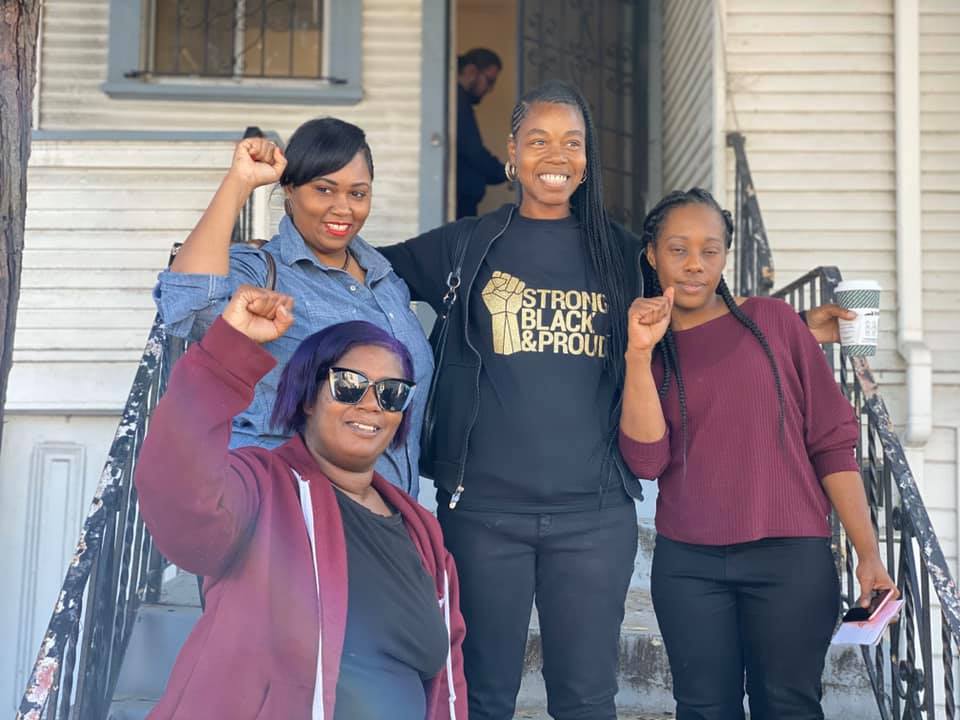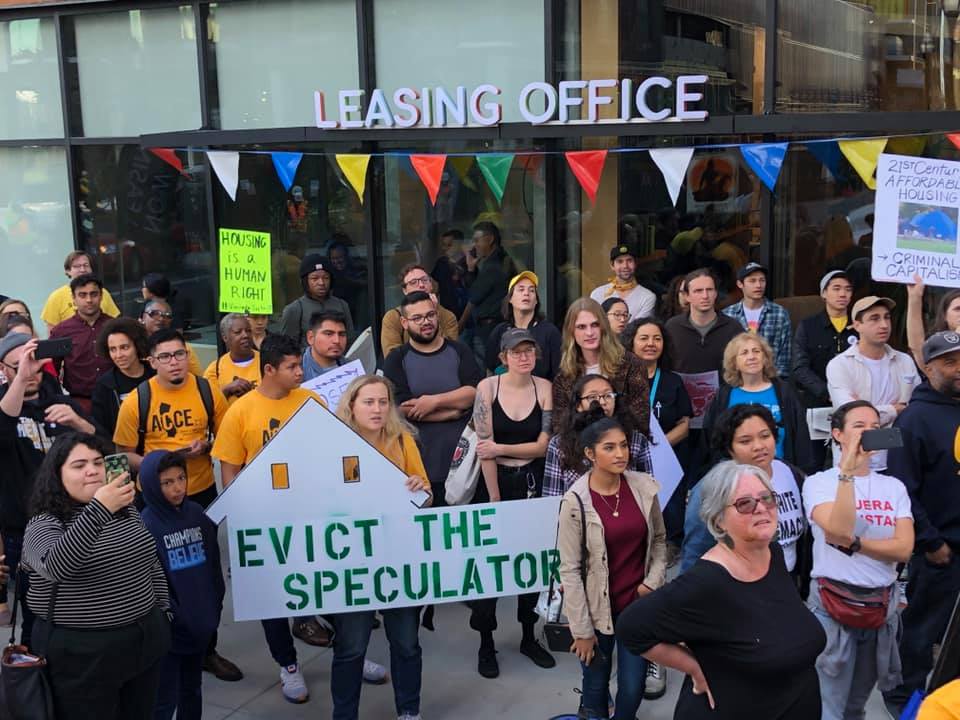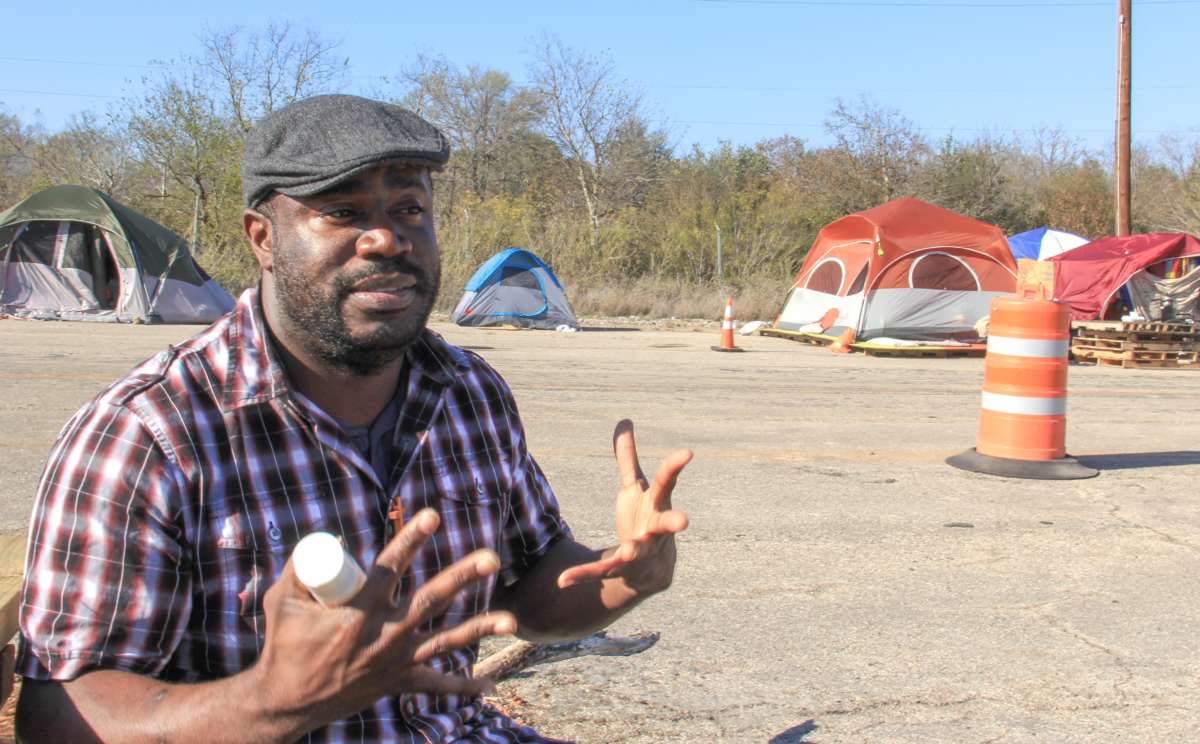
Despite working full time and playing by all the rules, Dominique Walker still found herself homeless in Oakland, one of several California cities where the housing affordability crisis is most dire.
She fled an abusive relationship in Mississippi, moving back to her hometown in April. Since then, she and her two children have stayed with relatives or bounced from hotel to hotel. “I go back to my same neighborhood and nobody’s there; everybody is displaced…. To grow up somewhere and come home to this, it was very shocking. It made me change the course and the direction of my own life,” Walker says.
Even with her job, she still needed help to afford an apartment. She thought she found that assistance when she became part of the largest housing solutions program in the Bay Area. The program, Bay Area Community Services, is backed by tens of millions of taxpayer dollars and helps guide homeless people into housing by providing financial assistance and planning.
“I went through the whole program, and when it got time for them to pay for my deposit and first month’s rent, … when I got all that together and went to the program, they told me their funding had been cut, and they couldn’t serve me,” Walker says.
She later found out the program had been misappropriating funds, with checks going at least one company that was not properly licensed. Worse, the program had placed people in garages infested with rats and black mold, and women in dangerous housing situations that made them vulnerable to sexual assault.
“I go back to my same neighborhood and nobody’s there; everybody is displaced.”
Walker’s experience with the program and the city’s housing politics made her realize that no one was coming to save her — that she couldn’t “depend on any government officials promising us or pacifying us with policies and not implementing it.” Under the banner of Moms 4 Housing, she and three other working mothers took matters into their own hands by reclaiming a vacant, investor-owned house on the 2900 block of Magnolia Street in November.
The three-bedroom home is owned by the Redondo Beach-based Wedgewood, one of many Bay Area companies that flips distressed properties to turn a profit. The four mothers say they are occupying the home to call attention the city’s “displacement machine” in which investors buy up properties and keep them vacant until they’re ready to be put on the market — a practice that has led to a ratio of about 3.8 vacant properties for every unsheltered person in Oakland.
With nearly 90 percent of all new apartments considered luxury or upscale, stagnant wages and an ever-rising cost of living, Oakland’s homeless population has jumped by 47 percent in the past two years, to about 4,071 — just over half of the total number of people experiencing homelessness counted in Alameda County on January 30, 2019. Likewise, the number of those living in their cars in Oakland has also grown over the past two years — to about 1,430 people, or by 131 percent.
The crisis has invariably hit Black people hardest. While Black residents made up only 24 percent of Oakland’s total population in 2017, 70 percent of those experiencing homelessness there in 2019 are Black, due to a long history of racist housing practices — from mid-century redlining practices to modern predatory lending. Rather than becoming unsheltered, many Black people have simply left: The last census count reported a 25 percent overall drop in the city’s Black population.
“Wedgewood won’t acknowledge us as human beings. They won’t acknowledge us as being in this house.”
Those who stay and live on the streets — or choose to fight back, like Walker — face increased criminalization efforts. The Alameda County Sheriff’s Office was previously set to evict the four mothers and their children December 17. The mothers filed a legal right-to-possession claim December 16, delaying the scheduled eviction until a court hears their case.
Walker says they woke up on December 3 to an eviction notice taped to their door — Wedgewood didn’t even address them in the notice. “Wedgewood won’t acknowledge us as human beings. They won’t acknowledge us as being in this house,” she says. “They’ve hired a PR firm instead of addressing us directly.”
The mothers are asking Wedgewood to negotiate the sale of the house at a price below its market rate since the company purchased the home after it was foreclosed on. Until then, Walker says, they aren’t going anywhere. Local organizers have rallied around them, vowing direct action in the face of potential arrests. The PR rep for Wedgewood told NBC that the company is willing to talk — after the mothers depart.
The mothers join 22 people who police arrested at City Hall last month in demanding that the city stop its sweeps and arrests of unsheltered people in public spaces. Further, they want the city to actually approve affordable housing projects that have applied for funds collected under the impact fee Oakland enacted three years ago. The city has received nearly $9 million in fees to fund affordable housing units from developers whose luxury units have displaced lower-income residents, but not a single affordable housing unit has been built so far. Most importantly, the mothers say they want speculators out of Oakland entirely.

The city’s housing advocates are beginning to see some wins. Oakland’s Human Services Department unveiled an ambitious five-year Plan To Address Homelessness in October that focuses on narrowing racial disparities with affordable housing and emergency intervention programs. Moreover, the city recently launched its first safe parking location for recreational vehicles. It’s also offering safe lots for people living in their cars and others to erect encampments.
Beyond Oakland, advocates are beginning to find traction in what has, until now, largely been an uphill battle. With the support of Gov. Gavin Newsom, they pushed through Assembly Bill 1482, a statewide rent control and “just cause” eviction bill package earlier this year. The new law comes after voters rejected a statewide ballot initiative in 2018 that sought to repeal the Costa-Hawkins Rental Housing Act, a 1995 special-interest law backed by the real estate industry that prevents cities from passing rent control policies.
Under AB 1482, which takes effect January 1, landlords of apartments buildings 15 years or older can hike rent no more than 5 percent (plus inflation) per year. The bill also forces landlords to provide a reason for evicting tenants, such as nonpayment of rent or criminal activity.
Crackdowns and Criminalization
But just as housing advocates begin to make small gains, the Trump administration is threatening a draconian crackdown on unsheltered people in several California cities that is expected any day. Their approach? To treat homelessness as a crime.
Department of Housing and Urban Development (HUD) officials are fielding options for how the administration might intervene, including horrifying proposals to destroy tent cities, use police to remove homeless people from the streets and potentially even detain homeless people in government-run facilities. The administration has promised such action after making steep cuts to federal housing programs that have only exacerbated the crisis.
“Trump has displayed far more compassion for the wealthy foreign investors than his actual, own citizens who are forced to live on the streets.”
National Law Center on Homelessness & Poverty Legal Director Eric Tars told Truthout the organization is already preparing for a potential legal challenge in the event of a crackdown. “Even if we able to stop these kinds of policies in courts, it’s my fear that the lasting damage will be the dehumanization of a very marginalized community that’s going to lead to more of these kind of attacks,” he says.
Last month, the Trump administration ousted the nation’s top homelessness official, Matthew Doherty, an Obama appointee who directed the U.S. Interagency Council on Homelessness, and replaced him with a private housing consultant, Robert Marbut, who has pushed to make handing out food to unsheltered people a crime. Instead of evidence-based, housing-first policies, which advocates agree is the most effective approach, Marbut wants to set up state-sanctioned temporary shelters that house people under coercive circumstances — in some cases, under threat of arrest.
While the administration hasn’t followed through on its threats just yet, it may already be working to obstruct California’s assistance efforts. Governor Newsom recently accused the administration of withholding the HUD 2019 homelessness data needed to release $650 million in state legislature-approved homelessness aid. The state has waited for the money since June.
“[Trump has] displayed far more concern and compassion for the wealthy foreign investors who are supposedly losing value on their investments than his actual, own citizens who are forced to live on the streets,” Tars says.
Trump isn’t the only elected official looking to shore up investors’ properties. Elsewhere in the nation, state governments are utilizing the president’s playbook. Texas Gov. Greg Abbott last month ordered state troopers and the Texas Department of Transportation to conduct sweeps of homeless encampments under Austin’s major highway overpasses.
The sweeps culminated the governor’s months-long campaign against the local unsheltered population and the city’s repeal of three ordinances that made public sitting, lying, camping or begging a crime. Like Trump, Abbott has similarly smeared people experiencing homelessness as prone to disease, sickness and violence.
“First they showed that they can put kids in cages. Now they’re looking for the next most vulnerable population and seeing how they can lock them up.”
Shortly after the sweeps, Abbott announced the designation of five acres of state-owned land in southeast Austin as a state-sanctioned homeless encampment. The Austin Chamber of Commerce then announced it was raising funds for a separate, 300-bed “mega-tent” shelter. The decisions were made unilaterally and without coordination with the city’s homeless service providers. Such state-sanctioned camps, which could be used to criminalize people camping in other locations, are exactly the kind of “solution” being eyed by Trump’s new homelessness czar Marbut.

“The way that Trump and Abbott are dehumanizing these homeless populations … is very similar to the fear-inducing rhetoric around immigrants that preceded the caging of children,” Tars says. “First they showed that they can put kids in cages, and there was some uproar, but ultimately they’re still putting kids in cages. Now they’re looking for the next most vulnerable population and seeing how they can lock them up.”
The tactic is also spreading at the municipal level. More and more cities are passing anti-homelessness laws restricting people’s ability to live in public spaces or in their vehicles, according to a recently released Law Center report. Almost three in four of the cities surveyed restrict camping in public in some way, the report found — a 15 percent increase since 2016. Since 2006, 13 new laws ban sleeping outside, and 45 new laws restrict sitting or lying down in public. During the same period, 64 new laws restricting vehicle dwelling were passed — a 213 percent increase.
This overall trend toward criminalization is occurring as the national rate of homeless people rose 2.7 percent in 2019, according to HUD. The criminalization issue almost made its way to the Supreme Court, which recently declined to hear a case on the legality of arresting unhoused people when no shelter beds are available.
Still, it seems the affordable housing crisis hasn’t broken through as a central issue in the presidential primary, even while a number of Democratic candidates have laid out comprehensive housing proposals, including Senators Bernie Sanders, Elizabeth Warren, Cory Booker and former HUD Secretary Julián Castro.
Homeless Bills of Rights “actually open up more political room for elected officials to do the best things rather than the convenient things.”
Yet, even in the absence of a robust national debate addressing increasing criminalization and affordable housing, housing advocates are finding ways to fight back. Advocates are pushing state-level bills in California, Minnesota, Oregon and Vermont that would not only overturn bans on camping or resting in public, but would also lay out enforceable human rights for people experiencing homelessness that would give them standing in court to sue when their rights are violated.
Homeless bills of rights, Tars says, “actually open up more political room for elected officials to do the best things rather than the convenient things…. Right now, we see communities using criminalization ordinances as a crutch to not have to take the steps that would actually end homelessness by being able to sweep it out of public view temporarily.”
City governments, he says, can hide the true costs of homelessness in their jail and policing budgets, instead of passing a housing bond or creating new taxes to construct affordable housing. Local politicians don’t want to have a zoning fight with “not-in-my-backyard” groups and other angry constituents during the interim years before ground can actually be broken on new housing facilities — and thus risk reelection. “The political incentives are all off, and having a homeless bill of rights can just change that baseline.”
He cautions, however, that the fight must extend far beyond the basic right to live outside, and toward a broader adoption of housing-first policies with a longer-term goal of permanent housing. It’s a policy position that cities are increasingly adopting, he says, despite recent federal and state-level attacks.
Housing First
Austin was already working toward temporary and long-term housing solutions under a housing-first framework before Abbott stepped in. Service providers and advocates there haven’t lost sight of that goal, even after the recent sweeps.
With more vacant buildings and housing units than there are unsheltered people, the main barrier to entry remains the logic of capital.
Last month, the Austin City Council unanimously approved a plan to convert a Rodeway Inn into the city’s newest shelter. The city plans to spend $8 million to pay for the building’s acquisition and renovation, and then lease the shelter to Austin’s Ending Community Homelessness Coalition (ECHO). The council will consider a second hotel for conversion in January.
“The idea is, we allow for extremely low-barrier access to move in, and provide supportive services on site. So bring a clinic in, bring primary care, bring psychiatric care, bring referral specialty care, bring substance treatment counseling, bring mental health counseling, bring peer support, bring case management all into the building, and allow people to access that in a harm reduction, housing-first kind of way,” says ECHO Executive Director Matthew Mollica.
Mollica was also involved in other efforts to acquire hotels to serve as bridge housing in San Francisco and Denver, and says the strategy has largely proven successful in getting people into permanent housing in the longer term. The approach is based on countless hours of service providers and advocates speaking directly with unsheltered people about their immediate needs — the major difference between the state and the city’s approach.
Tars agrees that purchasing of hotels is one part of a good solution. He points to the McKinney-Vento Act’s programs for emergency housing as another creative solution to get people off the streets in the short term. Under the act, public and private nonprofits can obtain vacant government properties and land to provide immediate housing to the unsheltered. With more vacant buildings and housing units than there are unsheltered people, the main barrier to entry remains the logic of capital.
“What we need is deterrence from our elected officials passing further incentives for high-end housing.”
Still, under the development incentives that continue to dominate large cities, even if every vacant building were utilized, it wouldn’t prevent more people from becoming homeless. “A lot of the communities where housing first is being implemented is being really successful, but you don’t see a reduction of people off the streets because the inflow is greater than the outflow,” Tars says. “And that’s this problem that’s been developing for the past 40 of just disinvestment in public housing.”
Rather than deterring people from sleeping outside, he says, “What we need is deterrence from our elected officials passing further incentives for high-end housing…. They’re the ones who should be held accountable for creating these conditions, not the people who have already been victimized by the process.”
For families like Walker’s in Oakland, though, having immediate access to a roof and four walls goes a long way: Her youngest son took his first steps recently at the Magnolia Street House. “For a child to be able to walk, they need to have some sort of freedom to crawl around and to get comfortable and confident to take those first steps,” Walker says, “That’s what has happened since we’ve had this house.”
Media that fights fascism
Truthout is funded almost entirely by readers — that’s why we can speak truth to power and cut against the mainstream narrative. But independent journalists at Truthout face mounting political repression under Trump.
We rely on your support to survive McCarthyist censorship. Please make a tax-deductible one-time or monthly donation.